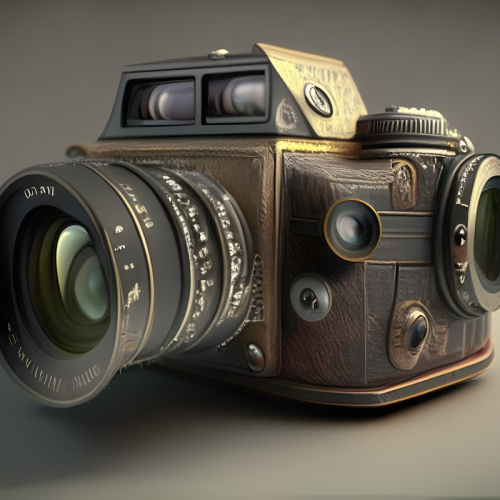The Fujifilm X100VI is a photographers' fixed-lens camera that combines a stabilized 40MP APS-C sensor with a 35mm equivalent F2 lens.

Key features:
- 40MP BSI CMOS APS-C X-Trans sensor
- 35mm equiv F2 lens
- In-body IS rated at up to 6EV of correction
- Hybrid optical/electronic viewfinder (3.69M dot OLED panel)
- Machine-learning trained subject recognition AF
- 14 film simulations
- 6.2K video capture and 10-bit recording
- Built-in 4EV ND filter
- Tilt up/down rear touchscreen
The X100VI is available now at an MSRP of $1599, a $200 increase over the previous models. Despite demand initially outstripping supply, the backlog does appear to be easing, somewhat.
What's new?
The biggest change in the X100VI is the addition of in-body image stabilization.
Interestingly, Fujfilm says the IS performance drops from 6.0EV of correction to 5.5EV of correction if you use the viewfinder in optical mode. The company has not given any insight into why this is the case.
| Very little appears to have changed on the back of the X100VI. Though hunt as you like, you won't find the phrase 'Made in Japan,' anywhere. We traditionally don't take a position on such issues but feel it's worth mentioning when it comes in conjunction with a price rise. |
The X100VI also sees a move to the 40MP BSI CMOS sensor used in the X-H2 and X-T5. It's a sensor that delivers high levels of detail capture, and from what we've shot so far, we don't have much concern about the lens's ability to make the most of this resolution bump.
The VI also features Fujifilm's X Processor V, that brings with it the machine-learning trained subject recognition algorithms. This means the X100VI has modes to recognize animals, birds, automobiles, motorcycles and bikes, airplanes or trains. As with other recent Fujifilm cameras, human face and eye detection is a separate mode, so you'll need to configure two buttons or positions on the Q Menu if you plan to swap between photographing people and a different subject type.
Film simulations
The X100VI gains the Reala ACE film simulation first seen in the GFX 100 II. Alongside this are added the Nostalgic Neg and Eterna Bleach Bypass simulations, taking the total number to 14 simulated filmstocks or 20 if you include the faux-color-filtered variations of the mono modes.
This is a lot to choose from, even for experimenting with them after the fact, using in-camera Raw conversion. For the most part, the options available represent film responses that you might actually choose to use, but the distinction between some modes is becoming quite subtle, and there's a balance between providing useful options and feature-bloat.
Camera to cloud
The X100VI becomes Fuijfilm's first camera to support the camera-to-cloud (c-2-c) system using its built-in Wi-Fi. This comes in addition to the usual Wi-Fi-to-smartphone options. It lets you pair the camera with a Wi-Fi network and then have the camera upload images and video directly to Adobe's Frame.io cloud-based collaboration platform. We found it was easy to set up and gives the option to auto upload files as they're created or to let you manually select the ones you wish to upload. You can select specific file types, too, so that it only uploads video or JPEGs, or just Raws or HEIFs, as you prefer.
Video
The X100 series has always offered video to some degree, but we've not heard of a lot of people making use of that capability. The X100VI offers essentially the same options as the X-T5 (itself not the company's most video-focused model), so you gain 10-bit recording, 6.2K capture from a 1.23x (43mm equiv) cropped region or 'HQ' 4K derived from this footage. This exhibits appreciable rolling shutter. Alternatively, there's sub-sampled 4K at up to 30p from the sensor's full with or at up to 60p with a 1.14x crop.
Like the recent GFX 100 II, the X100VI now has AF tracking in video mode, and this isn't restricted to the subjects it's been trained to recognize.
The X100VI has a mic input and can use its USB-C socket for audio monitoring, though, unlike the X-T5, no USB-to-3.5mm adapter is provided.
It's interesting to note that many movie mode settings are now accessible only when the camera is in Movie drive mode. This way, there's only a single page of basic video functions in the menu when you're shooting stills.
Other changes:
In addition to updating some of the camera's main specs, the X100VI also inherits many of the smaller refinements and updates that Fujifilm has developed in the four years since the last model was released. These include:
- HEIF capture
- Skin smoothing effect
- White priority and Ambience Priority Auto WB modes
- Custom AF zone areas
- Option to limit available AF area types for AF-S or AF-C shooting
- Pre-shot bursts (E-shutter + Cont H)
- Self-timer lamp on/off
- Interval shooting with an external timer
- Interval priority mode (prioritizes chosen interval, irrespective of exposure time)
Body and controls
The X100VI is 2mm deeper than the existing X100V, and 43g heavier. In practice, neither of these changes is especially noticeable. The camera still doesn't feel overly heavy.
The body's dimensions are similar enough to still fit in the existing LC-X100V leather camera case. It's also still compatible with the existing tele and wide-angle converter lenses. It uses the same lens as the previous model, so you can weather-seal the camera if you add the filter ring adapter and a filter of some sort.
The rear screen on the X100VI is a refinement of the tilting touchscreen on the previous model. It now tilts down a little further (45° rather than 30°) and pulls away from the body and viewfinder a little when tilted up for waist-level shooting. It's a small change, but a welcome one.
Controls
The control layout is identical to the previous model, with dedicated controls for aperture, shutter speed, exposure comp and ISO (albeit an ISO control that's fiddly to the point of primarily being decorative). As with previous models and many historic film cameras, the exposure mode is dictated by the position of the dedicated dials. Essentially you turn the dial to 'A' if you want the camera to control that value:
| Manual | Aperture Priority | Shutter Priority | Program | |
| Aperture ring setting | F-number | F-number | A | A |
| Shutter speed dial setting | Shutter speed | A | Shutter speed | A |
Exposure compensation is available in all modes, including Manual, if you have Auto ISO selected. And, since the shutter speed dial only has whole-stop steps, you can use a command dial to give you 1/3rd stop precision, ±2/3 EV from the value selected on the dial.
Command dials
In addition, there are two pressable command dials on the front and back of the camera, which can have a series of functions applied to them if the dedicated controls aren't being used.
By default, the camera's front clickable dial is set to control aperture, ISO and exposure comp (with a click of the dial cycling between the options). However, it doesn't actually let you control any of these things unless you consciously hand off control from the dedicated dials first.
This is where things get a little complicated: the exposure comp and ISO dials have dedicated 'C' positions to pass control over to the command dials. The shutter speed dial doesn't have a C position, so instead should be turned to its 'T' (Time) setting. The aperture ring doesn't have a C position but its 'A' (Auto) position can be reconfigured to act as 'C', via the menus. This may not be obvious, given the ISO dial has both an A and a C position, but this is where the X100 series development has brought us to.
We find it hard to imagine many people are assigning three settings to the command dials, and hence needing the pressable dials to make their function toggleable, but for most permutations we can anticipate, we think you can configure them only to the functions you want to control, so at least you won't accidentally press the dial and adjust anything unexpected.
Disappointingly, if you set ISO to 'A' you can't use a command dial to select between the three Auto ISO presets that you can configure. For that you'll need to select 'C' and be careful not to scroll the command dial too far and disengage Auto ISO altogether.

Hybrid viewfinder
The X100VI has the same hybrid optical/electronic viewfinder as its immediate predecessor. This has three modes: fully electronic, fully optical and optical with an inset electronic display.
As with all viewfinders that are offset from the lens and sensor, the optical finder is affected by parallax: when focused at infinity, the difference in position between the lens and viewfinder is irrelevant, but it becomes increasingly important as the focus distance decreases. Not only does the framing of the photo diverge at closer focus distances, the position of the AF points effectively moves down and to the right as you focus on closer subjects.
The X100VI finder includes the improvements made in firmware 2.0 for the X100V. A 'Corrected AF point' option (AF/MF Settings pg 3) displays a bracketed indicator in the OVF, showing where your AF point will move to if you focus close to the camera. Another menu option, 'Bright Frame Position Memory' (Setup/Screen Setup pg 1) lets you decide if you want the AF box to revert to infinity after each shot or stay at the correct position for the last time you focused. Between these two options, you should be able to get the OVF to work the way you're most comfortable with.
OVF inset tab
A quick note on the tab at the bottom right-hand corner of the OVF, which can be popped-up to have an electronic display projected onto it. In MF and AF-S modes, its default behavior is to show a magnified view of your chosen AF point, and you can press the rear dial to change the magnification. In AF-C mode, it simply shows the entire scene, so it isn't terribly useful.
Battery
The X100VI uses the same NP-W126S battery as the previous few X100 models. It's an 8.2Wh unit from which the camera is rated to deliver 450 shots per charge using the optical viewfinder or 310 shots if you use the EVF. The usual caveats come into play: in many shooting scenarios you can expect to get around double this number.
As you'd expect of a modern camera, you can charge the battery in the camera using a USB-C cable. As is becoming increasingly common, no offboard charger is supplied in the box to avoid electronic waste.









No comments, be the first to comment